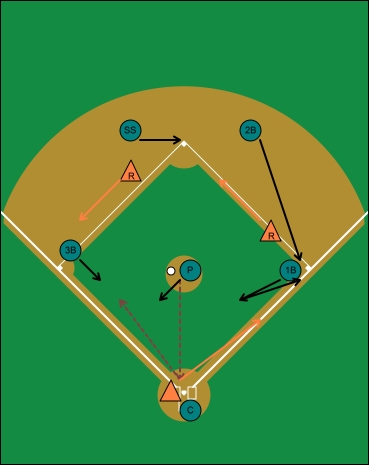|
Sacrifice Bunts ~ First Base, Second Base And First and Second ~ The Cornerstones Of Offensive Situations!
Sacrifice bunts, while they seem to be simple in nature, getting the desired result takes coaching, repetitions and the shared belief that this part of the game is essential to successful team baseball.
Below are diagrams and coaching points for each one of these offensive situations. While they are all similar, there are distinct and definate differences that make each one of them work, to their maximum potential.
Runner On First Base

- Hitter is bunting strikes only.
- Runner is getting a good secondary lead, making sure the ball is headed for the ground before he goes.
- Hitter is looking to bunt the ball up the first base side. The 1B is holding the runner on, so he will be slower charging the bunt.
- Balls bunted up either side, on the ground will be effective, balls bunted straight back to the mound more than likely become an unproductive out at second base, and sometimes become a double play.
Runner On Second Base

- Hitter is bunting strikes only.
- Runner is getting a good secondary lead, making sure the ball is headed for the ground before he goes.
- Hitter is bunting the ball up the third base side, past the pitcher so that the 3B has to field it.
- If the 3B fields the bunt, the runner will be safe. If the pitcher or the 1B field the ball, there is the possibililty of a play on the runner at 3B, thus an unproductive out.
Runners On First and Second

- Hitter is bunting strikes only.
- Runners get good secondary leads, making sure the ball is headed for the ground before they go.
- As with a runner at second, the hitter is bunting the ball up the third base side, past the pitcher so that the 3B must field the bunt.
- If the 3B fields the bunt, the runners will be safe. If the pitcher or first baseman field the bunt, there is a good chance one of the two runners will be out, as this situation is a force play, no tag required. Much easier out to convert.
Sacrifice Bunt Tips ~ From the Dugout

- Convince your players to stay in the box, bunt first/run second. Running before they bunt the ball is one of the most common mistakes players make.
- The most difficult aspect of bunting is getting the ball on the ground. Once they become proficient at that phase, they should have no trouble getting the ball up the proper side, so that the play is run for maximum effectiveness.
- Emphasize bunting strikes. If a pitcher is willing to walk you, take the walk, save the out and we have a new situation to work with.
- Attempting to bunt balls that are not strikes takes away your advantage.
Get Em On, Get Em Over, Get Em In!
Additional Topics On This Fun, Yet Overlooked Part Of The Game.
- Baseball offensive situations
Keep your opponents under pressure at all times
- Hit and run
Get your offense moving with this exciting and aggressive play
- Bunt and run
The short game adrenelin rush
- Fake bunt and steal
A great wrinkle to enhance the straight steal, providing your base runner with a little extra protection
- Fake bunt and hit
An effective way to get the defense to react to what they see, then the offense executes something entirely different
- Reading down angles
Get the jump on pitches in the dirt, take the extra base
- Special plays
Designed to amp up your running game through the element of surprise
- Safety squeeze, Suicide squeeze, Double squeeze
Initially the safest version, yet the most complicated to execute, a few seconds of pure excitement, the excitement of the suicide, with so much more
- Base running
One of the least taught, yet still one of the most important, even in the age of the aluminum bat
- Stealing second
As you step out into your lead, all the feelings intensify as you lock in on that one movement the pitcher is about to make, a movement that will send you speeding towards second base
- Stealing third
Often easier than stealing second
- Steal home
Always exciting and a true defensive demoralizer
- Double steal
Working to keep up the pressure, get two runners into scoring position or possibly score a run
- Delayed steal
Uses the element of surprise, a great equalizer
- Home to first
A full out sprint; remember, hustle never has a bad day
- First to second
Stay in the moment, be aggressive
- Second to third
The base runners first and foremost responsibility is to keep track of the baseball
- Third to home
The exception in leadoffs, as you lead off in foul territory
- First to third
The added skill involved is to pick up the third base coach, then second base, and the coach again
- 25 ways to score
25 reasons to work hard getting a runner on third base
return from sacrifice bunts to the ole ballgame.com
|
Have A Baseball Related Question?
 Click the image to visit our question page and have it answered. Due to my increased coaching schedule, I would ask that questions be limited to the following categories: Baseball Instruction, Baseball's Mental Game and Defensive and Offensive Situations. Don't have a question right now? Maybe you'd like to browse through questions already submitted. Each question becomes it's own web page on this site. Step up to the plate and put the ball in play! It only takes a few minutes. Solid resources for other categories: Baseball Resource
|









